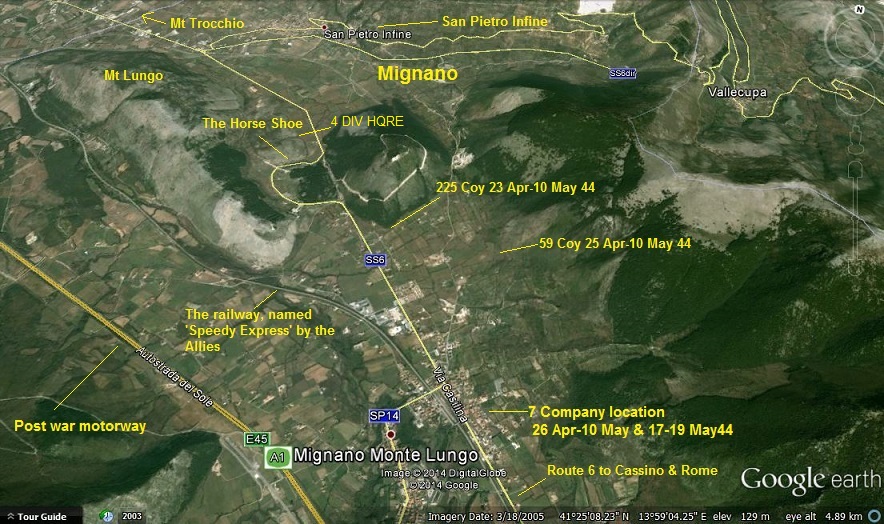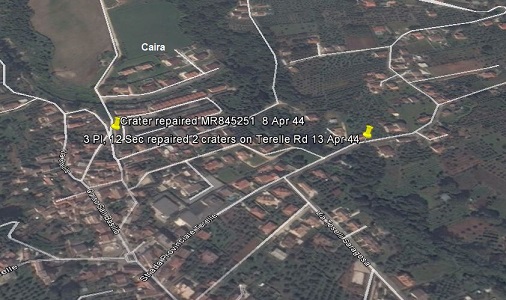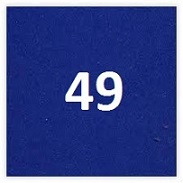Shiny 7 trail revisited May 2015
The Shiny 7 Trail 10-14 May 2015
The tour group stayed in the Hotel Rocca at Cassino and travelled by minibuses daily to the sites of the 4th Division RE in the period March - 2 June 1944.
The first site was San Castrese where 7 and 225 Field Companies first bivouaced on their arrival at The Italian Campaign in 1944.
The Group then went to Lauro and travelled down "Sun Track"to the Garigliano river and hills.
Right and below the Orange groves that were cleared of "S" mines by several Field Companies including 2 Platoon, 7 Fd Coy in March 1944
Below aerial view of some sites visited on 11 May 2015
In 1944 the High Command ordered the orange groves to be cleared of "S" mines so that oranges could be picked to supplement the rations for the men on the Front Line.
From Cerreci in 1944, the Shiny 7th moved up to Acquafondata, but for the sake of convenience the tour group moved on to where the three Field Companies did their Bridging Camps, and visited Acquafondata the following morning.
These are the areas where the Field Companies of the 4th Division RE trained on Bailey Bridge for the assault river crossings on the "Gustav Line"
From the 4th Division's rest area we proceeded to Pietrvairano and stopped at 59 Field Company's intensive bridging location. (photo above with Brian Singleton at the site) From Pietravairano we got on the SS6 (known as Route 6 in 1944) and visited 7 Field Company's location at Mignano where they prepared for the Rapido river assault crossings. All three Field Companies were in the Mignano area doing their respective preparations.

Whilst the Company stayed at this location they were very busy preparing for Operation “Honker”, the breaking through of the Gustav Line.
The main role of the Company was to build a class 30 Bailey bridge, clear mines and maintain routes to the forward areas. However, before that, they had to clear mines from, and widen the approaches to the bridge site, in what was then “no-man's” land, from the east side of Mt Trocchio to the river line. They also had to clear the railway line of mines and damaged rails to make it passable for wheeled and tank traffic from the southern end of Mt Trocchio to the level crossing in the 10 Inf Bde area near the Amazon bridge site, a distance of km 2.40. All these preparations had to be done at night in the dark and took two weeks. During this period 2 & 3 Platoons also went to intensive bridging camp near Pietravairano where we visited earlier.


From Mignano the tour continued along SS6 (Route 6 in old money) and passed the tank assembly areas for Operation Honker by Monte Porchio. Monte Porchio is located between Mignano and Monte Troccchio. See below.
Day two. 12 May 2015
On this the second day, there was less travelling involved. On day one there was a greater distance to cover and there were some tired faces at the end of the day. Anyhow, everyone survived, and day two was much easier and complimented with some spectactular scenery and excellent weather.
While on intensive bridging training 7 field Company built a 90 ft DS class 30 Bailey bridge twice a day for three days
The tour group then moved on to Acquafondata, this was the location the 4 Division Sappers moved to after their spell in the Garigliano Hills at San Castrese and Lauro. 7 Company came via a few days in Cerreci, where we had lunch the day before.
Acquafondata
Right: The start of the Inferno track as it is today.
Below; The same place photographed on 25 May 1944 manned by a NZ Provost
7 Field Company manned a water point at Acquafondata in April 1944
"Brighton" stores dump was located at Acquafondata
For this location see aerial view and map marked above M.R.932263
Sammy present day 7 Sqn and Chris 1960s veteran of 7 Sqn
view the 1944 training grounds of their forebears.
12 May 2015
Hove Dump photos taken 29 April and May 1944
Above: Hove Dump water point 29 April 1944.The three "S" tanks seen here in Hove Dump were placed there on 1st-2nd April by 4 Div Engrs, highly probable by 59 Coy who operated Jerry can filling water points in the lower end of the Inferno track, and at a house at the lower end of the North road just before S. Elia.
Hove Dump
Although located among the artillery gunlines Hove Dump was considered a safe and convenient harbour for supplies. The ammunition, petrol, rations, and even hay for the mules, were stacked in a clay-walled gully-a dry riverbed said to be an old course of the Rapido-and according to the artillerymen these walls gave immunity from enemy shellfire. Nevertheless, early in May, the Germans managed to land a few shells at the gully's narrow lower entrance, and set fire to a dump of pyrotechnics placed there by the Poles.German artillery activity increased noticeably on 6 May. Heavy calibre guns began to search out gun and mortar positions and laid several heavy concentrations round some of the headquarters positions and on supply roads and tracks. On the 7th, a fine day, shells began to drop into Hove Dump Eye-witnesses report that ‘a shellburst engulfed a jeep and a huge column of black smoke- probably from a load of petrol-spiralled up into the clear sky, a fine marker for enemy gunners. There was sudden, feverish activity. Drivers jumped to their jeeps and self-starters whirred. Trucks and jeeps, some blackened by fire, streamed out of the gully to safety. Obviously attracted by the smoke, the enemy guns poured shells into the dump, which soon became a blazing inferno, in which whole stores of petrol and ammunition exploded. ‘Viewed from afar by awed onlookers, Hove appeared as a deep gash in the earth from which billowed smoke and flame and with them shuddering explosions. Even stacks of super-heated bully beef were bursting like small-arms fire.
According to German records, observers had seen the constant movement of traffic into and out of the gully north of Portella. Presumably because the guns to the north and north-west could not clear the crests, 1 Parachute Division's artillery in the Cassino area was laid on this target on 6 May. A German report next day says that after movement in the gully was shelled, 20 explosions were seen, followed by fires which lasted for a long time. Petrol and ammunition had obviously been hit….’ This shelling was continued on 8 and 9 May, when more fires and explosions were reported.



The tour group visited the sites in Caira marked by the yellow pins
Day two.
After lunch the group visited the the approaches to the three bridge sites, which included visiting the Congo and Blackwater bridge sites. The group learned what preparation was done to enable the vast amount of vehicles arrive at the bridges.
The approaches to the bridge sites went from the east side of Mt Trocchio via the north and south of it's tips.
First of all we visited the approaches from the northern tip. These approaches, including vehicle assembly areas, were in 10 Inf Bde area and were tasked out to 225 Fd Coy and 59 Fd Coy. The tank route was tasked to 8 Fd Sqn RE who were under command C.R.E 4 Division. We drove down some of the routes and stopped at the vehicle assembly area. A blown up sketch map, taken from the CRE's War Diaries of the approaches with task numbers was produced to help illustrate the tasks.
See above
we parked here
The group also visited the Blackwater site
The Cassino tour 2015
Last year we commemorated the 70th anniversary of the Amazon Bridge. This year the tour group went one better and actually followed the Shiny 7th’s path of the time they landed at Naples until they went to rest camp after the Gustav Line had finally fallen. The tour group comprised of families of the Shiny 7th that were in the Italian Campaign, present day members of the Squadron, former members of 7 Field Squadron, 59 Cdo Sqn and guests. The aim of the tour was to pay tribute to the men of the Shiny 7th by following their footsteps, learning what they went through, and trying to understand the hardships and sacrifices they had to endure. The fine weather we had contributed to a very enjoyable and memorable occasion, which made us all a little wiser of the great endeavours and feats of the group’s fathers and forebears.
7 Field Company were billeted on site behind the group
225 Fd Coy in this area 7 Fd Coy in this area
Day 3. 13 May we commemorated the 71st Anniversary of the Amazon Bridge, visited the Polish War Cemetery, The Monestry, CWGC Cemetery, Cassino & Venafro museums
Shortly after 7 Company arrived in Castrese it was shelled. Sadly two children were killed and Lt M.N.Sharland R.E. witnessed the funeral and wrote the first of his poems of scenes in Italy. He intended to give the poem a title later. Sadly he was K.I.A on the 19-7-1944
- A tribute to the 4th Division Engineers February - June 1944
A little cobbled courtyard,
in a dirty narrow town,
with its barren battered houses
with their plaster falling down.
Two simple little coffins
on drooping shoulders borne-
a group of aged peasants,
their faces lined and drawn.
Two rough unfinished coffins,
a haggard surplice priest,
clutching his faded bible
with its pages torn and creased.
The slow procession faltered,
then passed into the street
and wondering children followed
on dirty unshod feet.
Up between the houses
battered now and scarred,
and the chickens went on scratching
by the muck-heap in the yard.
Lt M.N. Sharland R.E., R.I.P.
The map above shows the war time part of the North Road and the Inferno Track




















